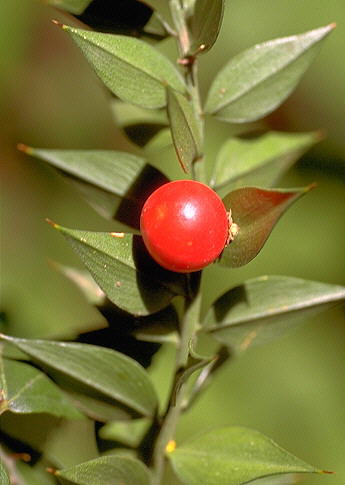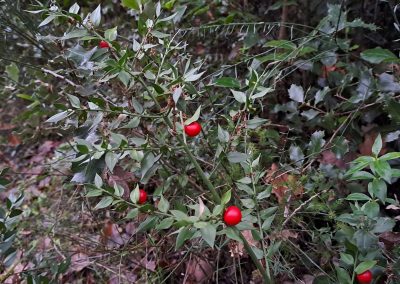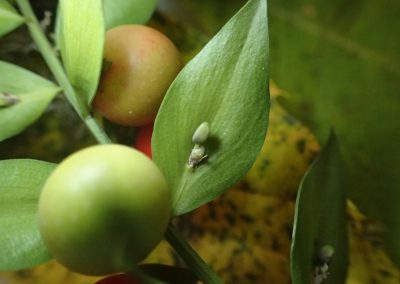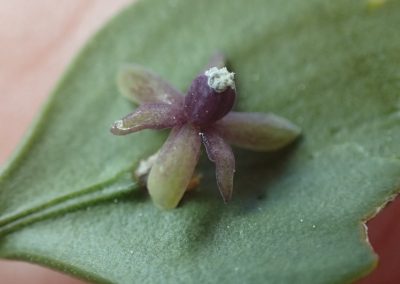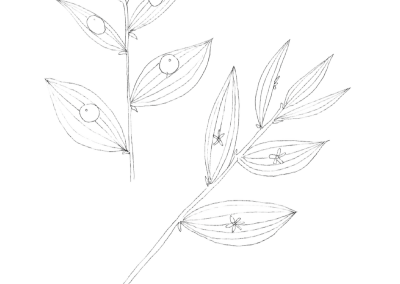Ruscus aculeatus
Scientific description
Taxon: Ruscus aculeatus
Class: Liliopsida
Subclass: Liliidae
Order: Asparagales
Family: Asparagaceae
Common name: Butcher’s broom
Origin:
Europe and Mediterranean region.
Description:
Small perennial shrub, evergreen, 30–60 cm tall. True leaves reduced and replaced by spiny, rigid, flat cladodes (false leaves). Small greenish flowers in axils of cladodes. Bright red berries visible in autumn and winter. Grows in shaded, cool understories, calcareous or moist soils, forest edges, and Mediterranean hedgerows.
Propagation:
By seeds dispersed by birds; also by rhizome division.
Ecology:
Shade-loving plant of dense woods and understories, important for local wildlife. Tolerant to shade and poor soils.
Uses:
Traditional herbal medicine (circulatory system). Ornamental for evergreen foliage and decorative berries.
Threats:
Not threatened. Common within its range, sometimes locally reduced by deforestation.
Taxon: Ruscus aculeatus
Classe: Liliopsida
Sous-classe: Liliidae
Ordre: Asparagales
Famille: Asparagacées
Nom commun: Fragon petit houx
Origine:
Europe et région méditerranéenne.
Description:
Petit arbuste vivace à feuillage persistant, 30–60 cm. Feuilles véritables réduites, remplacées par des cladodes épineux et plats. Petites fleurs verdâtres à l’aisselle des cladodes. Fruits rouges brillants visibles en automne et hiver. Croît dans sous-bois ombragés et frais, sols calcaires ou humides, lisières de forêt et haies méditerranéennes.
Multiplication:
Par graines dispersées par les oiseaux ; par division des rhizomes.
Écologie:
Plante ombrophile des bois et sous-bois denses, importante pour la faune locale. Résistante à l’ombre et aux sols pauvres.
Utilisation:
Phytothérapie traditionnelle (circulation sanguine). Ornementale pour son feuillage persistant et ses baies décoratives.
Menace:
Non menacée. Espèce commune dans son aire, parfois réduite localement par déforestation.
Taxon: Ruscus aculeatus
Clasă: Liliopsida
Subclasă: Liliidae
Ordin: Asparagales
Familie: Asparagaceae
Nume comun: Măturică
Origine:
Europa și regiunea mediteraneană.
Descriere:
Arbust peren, veșnic verde, 30–60 cm. Frunzele adevărate reduse, înlocuite de cladode spinoase, rigide și plate. Florile verzi apar la axila cladodelor. Fructe roșii strălucitoare vizibile toamnă–iarna. Crește în păduri umbroase, soluri calcaroase sau umede, margini de păduri și garduri vii mediteraneene.
Propagare:
Prin semințe răspândite de păsări; prin divizarea rizomilor.
Ecologie:
Plantă iubitoare de umbră, importantă pentru fauna locală. Tolerantă la umbră și soluri sărace.
Utilizare:
Fitoterapie tradițională (circulație sanguină). Ornament pentru frunziș veșnic verde și fructe decorative.
Amenințări:
Nu este amenințată. Specie comună, uneori redusă local prin defrișări.
Ταξινόμηση: Ruscus aculeatus
Κλάση: Liliopsida
Υποκλάση: Liliidae
Τάξη: Asparagales
Οικογένεια: Asparagaceae
Κοινή ονομασία: Αγκαθωτός ασπάλαθος
Προέλευση:
Ευρώπη και Μεσογειακή περιοχή.
Περιγραφή:
Μικρός αειθαλής θάμνος 30–60 εκ. Αληθινά φύλλα μειωμένα, αντικαθιστώνται από αγκαθωτά, επίπεδα κλάδοκα. Μικρά πρασινωπά άνθη στις μασχάλες των κλάδοκα. Καρποί κόκκινοι ορατοί φθινόπωρο–χειμώνα. Αναπτύσσεται σε σκιασμένα, δροσερά υποδάση, ασβεστολιθικά ή υγρά εδάφη, όρια δασών και μεσογειακές φράχτες.
Διάδοση:
Με σπόρους που διασκορπίζονται από πουλιά. Επίσης με διαίρεση των ριζωμάτων.
Οικολογία:
Φυτό που αγαπά τη σκιά, σημαντικό για την τοπική πανίδα. Ανθεκτικό στη σκιά και φτωχά εδάφη.
Χρήση:
Παραδοσιακή φυτοθεραπεία (κυκλοφορία αίματος). Διακοσμητικό για φύλλωμα και καρπούς.
Απειλές:
Δεν απειλείται. Κοινό είδος, τοπικά μειωμένο από αποψίλωση.
Creative writing inspired by Ruscus aculeatus
The fragon petit houx
In the world of mortals lived a young girl, Anastasia, who had an innate curiosity to explore and discover the world and its secrets. One afternoon, she decided to go for a walk in the forest and took a basket with her to gather fruits and nuts. As she strolled along, some red fruit caught her eye. These were the fruits of the famous fragon plant, petit houx. Enthralled by their color, she approached them and began to eat them non-stop. At one point, she felt uncomfortable and went to the river to drink some water.
There she meets a wise old man who tells her she shouldn't eat so much of the fruit, as large quantities can become poisonous. Anastasia feels pain and faints. When she wakes up, the old man is still there, saving her with his prayers and magic formulas. Anastasia thinks he's the one who's hurt her and runs home. But she forgets her basket in the forest.
The next day, she goes to the same place to see if she can find it, but instead she finds a book with recipes using fragon petit houx as ingredients, and on the last page she finds spells with the same plant, used to protect people and nature. She scrupulously observes the dosages, as large quantities of the plant can have disastrous effects.
On her way home, she sees the old man waiting for her by the river. He comes up to her and says: "Now the saving of this world belongs to you, for you have found the book. Always keep goodness and morality as your guide." And he leaves.
From then on, Anastasia takes it upon herself to save the world from evil, using the old man's words and the secrets of the fragon petit houx as her compass.


